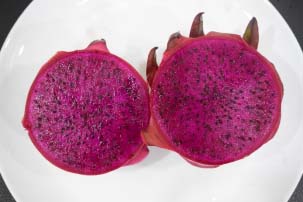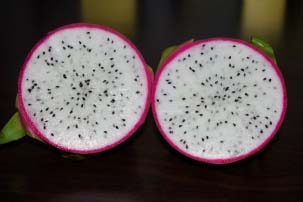Dragon fruit (Hylocerus sp), is a nutritious fruit mainly available in three variants viz.

- Red skin with white pulp (Hylocereus undatus)
- Red skin with red pulp (Hylocereus monacanthus previously known as H. polyrhizus)
- Red skin with purple pulp (Hylocereus costaricencis)
- Yellow skin with white pulp (Hylocereus megalanthus previously known as Selenicereus megalanthus).
| Kingdom | Plantae |
| Class | Angiosperms |
| Order | Caryophyllales |
| Family | Cactaceae |
| Genus | Hylocereus |
| Species | monacanthus |
| Botanical Name | Hylocereus monacanthus |
REQUIREMENTS:
- Soil – It can be grown in a wide variety of soil but rich in organic matter with slight acidic is best for its cultivation.
- pH – The ideal pH for Dragon Fruit cultivation is 5.5 to 7.5 however it can tolerate maximum of 8.5 pH and minimum of 4.0 pH.
- Temperature – It prefers dry tropical climate with average temperature 20 – 290 C but it withstand temperatures of 38 – 40℃, and as low as 0℃ for short periods (Karunakaran, et.al., 2014).
- Elevation – It can be cultivated successfully up to an elevation of 900 meter above mean sea level.
- Climate – It is hardy in nature and performs well in dry, semi-arid and subtropical conditions.
- Irrigation Water – The EC of water should be less than 1.0 dSm-1 for its successful cultivation.
Nutritional composition of Dragon Fruit (per 100g of edible portion) –
| Nutrient | Amount (per 100 g) |
| Water | 87 g |
| Protein | 1.1 g |
| Fat | 0.4 g |
| Carbohydrates | 11.0 g |
| Fiber | 3.0 g |
| Vitamin B1 (Thiamine) | 0.04 mg |
| Vitamin B2 (Riboflavin) | 0.05 mg |
| Vitamin B3 (Niacin) | 0.16 gm |
| Vitamin C (Ascorbic Acid) | 20.5 mg |
| Calcium (Ca) | 8.5 mg |
| Iron (Fe) | 1.9 mg |
| Phosphorus (PP | 22.5 mg |
| Health Benefits – |
| Dragon fruit has an extremely low amount of cholesterol, which ultimately reduces the chance of heart attack |
| It contains protein as well as omega-3 and omega-6 fatty acids that can help prevent cardiovascular diseases. |
| Dragon fruits are rich in fibre so it aids in digestion of food |
| It is a good natural source of anti-oxidants, which help to prevent the dangers of free radicals, which can cause cancer and other undesirable health detriments. |
| It contains Vitamin C which enhances the immune system and stimulate other antioxidant in the body. |
Dragon Fruit –
| Red Dragon Fruit – The pulp & skin are red in colour having sweet taste. It resembles kiwi in taste. |  |
| White Dragon Fruit – The skin is red while the pulp is white in colour. It is less sweet to taste & feels like a grape in flavour. |  |
The Package of practices are prepared in following order –
– Care of young plants before plantation
– Plantation – Earthing Up Level
– Grading
– Post Harvest Management Packaging
References:
https://cutm.ac.in/wp-content/uploads/sdg/pdf/R1_Dragon-Fruits-Action-Reserach-Project-Report.pdf
https://krishi.icar.gov.in/jspui/bitstream/123456789/23809/1/Dr.Karunkaran%2C%20vetnum%20proceeding%20.pdf
Thokchom et al., 2019
https://ijhst.ut.ac.ir/article_80693_30cfe598b15e300767dcd5f8f646f175.pdf









